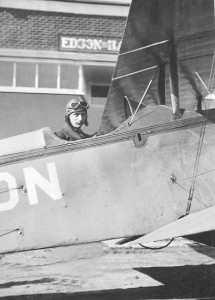The First Use of an Aircraft for Police Pursuit, 1919
by John Chalmers
Little can be read about Canadian aviation without coming upon the name of Wilfrid Reid “Wop” May, OBE, DFC, who first was written into the history books for service with the Royal Flying Corps in the First World War.
One of his well-known adventures was a January 1932 flight to pursue Albert Johnson, “the mad trapper of Rat River,” for the shooting death of RCMP constable Edgar Millen. But a less well-known flight in September 1919 was the first use of an aircraft for police pursuit.
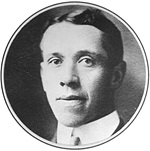
On August 30, 1919, about 3:00 a.m., Constable William Nixon of the Edmonton police force approached a suspicious character outside a downtown Edmonton business. The man pulled out a revolver, shot Nixon and fled.
On September 1, Nixon died of his wounds, but had given a description matching that of John Gundard Larsen, a known offender recently released on parole after being jailed for forgery.
On September 2, Police Chief George Hill recruited Wop May to fly detective James Campbell to Edson, Alberta in May’s Curtiss JN-4 biplane. Larsen was known to have purchased a ticket on the Grand Trunk Pacific Railway for Edson – and the chase was on.
At Edson, Wop May landed the aircraft on a street in the town, and Detective Campbell was joined by Constable McElroy of the Alberta Provincial Police to pursue the fugitive into the coal branch mining area south of Edson, where Larsen was known to be heading. Joining the search were members of the Royal North-West Mounted Police and other men from the area, some 50 in total.
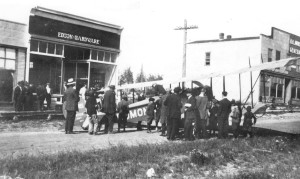
When May departed from the main street in Edson to fly back to Edmonton; as he began his take-off run, a wing clipped the town water pump. After checking to make sure the aircraft was airworthy, May lifted off for the return flight. “I was travelling against a wind that was blowing about forty miles an hour, and at a height of 2,000 feet, and owing to this, the machine had run out of gas and I was obliged to force a landing at Wabamun in order to refill the tank,” May said in the The Morning Bulletin of September 4, 1919, “I might say that this landing was another difficult one as I could only descend in a small rough field. Upon leaving Wabamun I was obliged to head off through this narrow field in a course that brought the machine in contact with the tops of trees, which made it necessary to dive the machine into the water in order to gain speed. However, the trip from there to Edmonton was made without any further difficulty.”
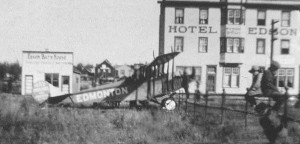
Campbell and McElroy soon captured Larsen, who escaped from them for a day and was then recaptured at gunpoint by the two policemen. Returned to Edmonton by train, John Larsen was eventually convicted of armed robbery and attempted murder for an attack on another policeman while awaiting trial. Larsen was sentenced to life imprisonment, but the charge of murdering Constable Nixon was not proven, although there is little doubt who killed the policeman.
Re-enactment of the 1919 Flight
On August 29, 2009 the air pursuit was re-enacted by the Alberta Aviation Museum in Edmonton. The flight to Edson was the fourth re-enactment of historic flights using a Kelly-D biplane acquired for celebrating Canada’s Centennial of Flight in 2009. The pilot on all four flights was the museum’s executive director, Tom Hinderks. On this fl ight, Hinderks took the place of Wop May in the cockpit.
Taking the place of Detective James Campbell was Staff Sergeant Chris Barbar, a helicopter pilot of the Air-1 police helicopter of the Edmonton Police Service. Just as in 1919, a city police officer flew in the pursuit. But police involvement didn’t end there. During the re-enactment, the biplane was escorted out of the city by the police helicopter.
On the ground, a convoy of 30 vintage vehicles followed the biplane all the way to Edson, led by the EPS 1964 black-and-white police cruiser driven by Constable Dan Hunter. Police held traffic at intersections until the convoy reached the western end of the city limits. Half an hour east of Edson, Sgt. Jim Desautels of the Edson RCMP detachment met the convoy for escort to the Edson airport where another 30 special interest vehicles from the Edson area joined those from Edmonton.
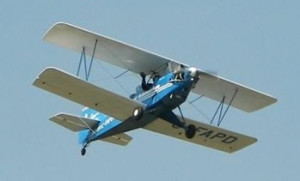
As in the flight of 1919, the re-enactment flight 90 years later faced problems. Fog in Edson and for 60 kilometers east necessitated diverting the Kelly-D to Drayton Valley to wait out the fog, eventually landing on a sunny day two hours later to a reception and barbeque. Wop May refueled on the way home. Tom Hinderks had to refuel on the way to Edson, but the return flight was non-stop in a perfect day for flying.
Captain Wilfrid ‘Wop’ May was inducted into Canada’s Aviation Hall of Fame in 1974. Detective Campbell, who brought Larsen to face his crimes, served with EPS until his death in 1934 and is buried in Edmonton.
Constable William Nixon joined the Edmonton police in 1912, enlisted in the army at the outbreak of the First World War, and survived major battles like Ypres, Passchendale and Vimy. He was decorated with the Military Medal for bravery and after the war he returned to the police force in Edmonton, only to be gunned down on a street of the city he served. Following his death, which prompted the first police pursuit by air, he was honoured with a funeral parade several blocks long. His body was placed on a C.P.R. train and shipped to his home town of Ingersoll, Ontario for burial.
And what of the Curtiss biplane that made the flight in 1919? It was preserved, restored and today hangs at the entrance of the Reynolds-Alberta Museum, home of Canada’s Aviation Hall of Fame.
Re-creation of Keith Davidson’s March 2002 Article in the Edmonton Examiner
Manhunt
2:45 am, CPR Depot, Edmonton, August 30, 1919. Edmonton City Police Constable Hugh Nixon approached a man standing at the side entrance of the Twin City Transfer in Edmonton, He asked the man what he was doing and the man pulled out a gun and shot him.
On September 1st the police got a break – the had been an attempted murder in a district west of Edmonton – the description matched that of the man given by Constable Nixon before he died. They already had a warrant for the man, John Larsen on a hold-up charge. The fugitive was heading west.
Police Chief Hill hired “Wop” May to take Detective James Campbell to search for the man. They left Edmonton on September 2nd – It was the first airplane chase on record in the Dominion of Canada. They searched the bush west of Edmonton but could not find a place to land, and headed on to the town of Edson – “Wop” managed to set the plane down between the telegraph wires near the train station.
“Wop” took off on the main street of Edson, hitting the town pump with his wing as he turned the Curtiss “Canuck”aircraft around. After landing at Wabamun for fuel he took off again, for Edmonton.
Larsen was arrested by James Campbell and Alberta Provincial Police Constable McElroy near the Cadomin Mine and rather than wait for the train commandeered a railway speeder and headed for Edson. During the ride Larsen threw himself off the speeder and headed into the bush. He was re-captured and after a trial was sentenced to life imprisonment.
Thanks to Keith Davidson, writer for the Edmonton “Examiner” for his research & article in March of 2002.
